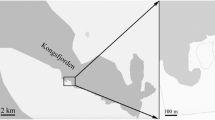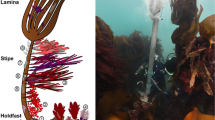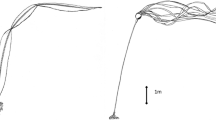Abstract
Kelp forests are patchy fish-associated habitats, which can vary greatly in their size, foundation species, and several physical habitat attributes. The structure of fish assemblages can vary with these characteristics and with the location of the assemblage within the forest, i.e. edges versus interiors. This study quantified the biological and physical heterogeneity within different sized kelp forests and identified which factors are important in structuring the associated fish assemblages. Fish and habitat surveys were conducted at the edge and interiors of ten kelp forests of varying sizes in Kachemak Bay, south-central Alaska. Fish assemblage structure was not correlated with the species composition of surface canopy forming foundation kelps (Nereocystis leutkeana and Eualaria fistulosa) or with kelp forest size. Instead, it correlated with the abundances of two understory foundation kelps (Agarum clathratum and Saccharina latissima), substratum rugosity, and water depth. Together these benthic attributes explained 53.6 % of the fish assemblage variability. Additionally, significantly different fish assemblages were found at edge compared to interior locations with the relative abundance of seven species (Artedius fenestralis, Ammodytes hexapterus, Blepsias cirrhosis, Gadus macrocephalus, Hexagrammos stelleri, Pholis laeta, and Sebastes melanops) explaining 91.4 % of the variability. This study highlights the importance of habitat characteristics such as understory foundation species, substratum rugosity, water depth and location within a patch on the variability of fish assemblages in high latitude kelp forests.






Similar content being viewed by others
References
Abookire AA, Duffy-Anderson J, Jump C (2007) Habitat associations and diet of young-of-the-year Pacific cod (Gadus macrocephalus) near Kodiak, Alaska. Mar Biol 150:713–726
Andrews KS, Anderson TW (2004) Habitat-dependent recruitment of two temperate reef fishes at multiple spatial scales. Mar Ecol-Prog Ser 277:231–244
Angel AF, Ojeda FP (2001) Structure and trophic organization of subtidal fish assemblages on the northern Chilean coast: the effect of habitat complexity. Mar Ecol-Prog Ser 217:81–91
Armstrong RH (1996) Alaska’s fish: a guide to selected species. Alaska Northwest Books, Anchorage
Bender D, Contreras T, Fahrig L (1998) Habitat loss and population decline: a meta-analysis of the patch size effect. Ecology 79:517–533
Beukers JS, Jones GP (1998) Habitat complexity modifies the impact of piscivores on a coral reef fish population. Oecologia 114:50–59
Blackburn JE, Anderson PJ (1997) Pacific sand lance growth, seasonal availability, movements, catch variability, and food in the Kodiak-Cook Inlet area of Alaska, International Syposium on the Role of Forage Fishes in Marine Ecosystems. Alaska Sea Grant College Program, Anchorage, Alaska, USA
Bodkin JL (1986) Fish assemblages in Macrocystis and Nereocystis kelp forests off central California. Fish B-NOAA 84:799–808
Bodkin JL (1988) Effects of kelp forest removal on associated fish assemblages in central California. J Exp Mar Biol Ecol 117:227–238
Carr MH (1989) Effects of macroalgal assemblages on the recruitment of temperate zone reef fishes. J Exp Mar Biol Ecol 126:59–76
Clarke K, Warwick R (2001) Change in marine communities: an approach to statistical analysis and interpretation, 2nd edn. PRIMER-E, Plymouth
Clarke K, Gorley R (2006) PRIMER v6: user manual/tutorial. PRIMER-E, Plymouth
Cole RG, Davey NK, Carbines GD, Stewart R (2012) Fish-habitat associations in New Zealand: geographical contrasts. Mar Ecol-Prog Ser 450:131–145
Connell SD, Jones GP (1991) The influence of habitat complexity on postrecruitment processes in a temperate reef fish population. J Exp Mar Biol Ecol 151:271–294
Dayton PK (1971) Competition, disturbance, and community organization: the provision and subsequent utilization of space in a rocky intertidal community. Ecol Monogr 41:351–389
Dayton PK (1985) Ecology of kelp communities. Annu Rev Ecol Syst 16:215–245
Dill LM (1990) Distance-to-cover and the escape decisions of an African cichlid fish, Melanochromis chipokae. Environ Biol Fish 27:147–152
Ebeling AW, Laur DR (1985) The influence of plant cover on surfperch abundance at an offshore temperate reef. Environ Biol Fish 12:169–179
Edgar GJ, Barrett NS, Morton AJ, Samson CR (2004) Effects of algal canopy clearance on plant, Fish and macroinvertebrate communities on eastern Tasmanian reefs. J Exp Mar Biol Ecol 312:67–87
Fahrig L (2003) Effects of habitat fragmentation on biodiversity. Annu Rev Ecol Evol S 34:487–515
Gaines SD, Roughgarden J (1987) Fish in offshore kelp forests affect recruitment to intertidal barnacle populations. Science 235:479–481
Hamilton J, Konar B (2007) Implications of substrate complexity and kelp variability for south-central Alaskan nearshore fish communities. Fish B-NOAA 105:189–196
Hixon MA, Beets JP (1993) Predation, prey refuges, and the structure of coral-reef fish assemblages. Ecol Monogr 63:77–101
Jelbart JE, Ross PM, Connolly RM (2007) Patterns of small fish distributions in seagrass beds in a temperate Australian estuary. J Mar Biol Ass U K 87:1297–1307
Johnson MP, Frost NJ, Mosley MWJ, Roberts MF, Hawkins SJ (2003a) The area-independent effects of habitat complexity on biodiversity vary between regions. Ecol Lett 6:126–132
Johnson SW, Murphy ML, Csepp DJ (2003b) Distribution, habitat, and behavior of rockfishes, Sebastes spp., in nearshore waters of southeastern Alaska: observations from a remotely operated vehicle. Environ Biol Fish 66:259–270
Jorgensen SJ, Kaplan DM, Klimley AP, Morgan SG, O’Farrell MR, Botsford LW (2006) Limited movement in blue rockfish Sebastes mystinus: internal structure of home range. Mar Ecol-Prog Ser 327:157–170
Levin PS (1993) Habitat structure, conspecific presence and spatial variation in the recruitment of a temperate reef fish. Oecologia 94:176–185
Lima SL, Dill LM (1990) Behavioral decisions made under the risk of predation: a review and prospectus. Can J Zoolog 68:619–640
Love M, Carr M, Haldorson L (1991) The ecology of substrate-associated juveniles of the genus Sebastes. Environ Biol Fish 30:225–243
Love MS, Yoklavich M, Thorsteinson L (2002) The rockfishes of the northeast Pacific. University of California Press, Berkeley
MacArthur RH (1965) Patterns of species diversity. Biol Rev 40:510–533
Napazakov V (2010) The diet of white-spotted greenling Hexagrammos stelleri (Hexagrammidae) on the West Kamchatka shelf. J Ichthyol 50:100–104
Öhman MC, Rajasuriya A (1998) Relationships between habitat structure and fish communities on coral and sandstone reefs. Environ Biol Fish 53:19–31
Opdam P, Wascher D (2004) Climate change meets habitat fragmentation: linking landscape and biogeographical scale levels in research and conservation. Biol Conserv 117:285–297
Pérez-Matus A, Shima JS (2010) Disentangling the effects of macroalgae on the abundance of temperate reef fishes. J Exp Mar Biol Ecol 388:1–10
Pérez-Matus A, Ferry-Graham LA, Cea A, Vasquez JA (2007) Community structure of temperate reef fishes in kelp-dominated subtidal habitats of northern Chile. Mar Fresh Res 58:1069–1085
Rangeley RW, Kramer DL (1998) Density-dependent antipredator tactics and habitat selection in juvenile pollock. Ecology 79:943–952
Reisewitz S, Estes J, Simenstad C (2006) Indirect food web interactions: sea otters and kelp forest fishes in the Aleutian archipelago. Oecologia 146:623–631
Scott WB, Scott MG (1988) Atlantic fishes of Canada. University of Toronto Press, Toronto
Siddon EC, Siddon CE, Stekoll MS (2008) Community level effects of Nereocystis luetkeana in southeastern Alaska. J Exp Mar Biol Ecol 361:8–15
Smith TM, Hindell JS, Jenkins GP, Connolly RM (2008) Edge effects on fish associated with seagrass and sand patches. Mar Ecol-Prog Ser 359:203–213
Smith TM, Hindell JS, Jenkins GP, Connolly RM (2010) Seagrass patch size affects fish responses to edges. J Anim Ecol 79:275–281
Smith TM, Hindell JS, Jenkins GP, Connoll RM, Keough MJ (2011) Edge effects in patchy seagrass landscapes: The role of predation in determining fish distribution. J Exp Mar Biol Ecol 399:8–16
Tupper M, Boutilier R (1997) Effects of habitat on settlement, growth, predation risk and survival of a temperate reef fish. Mar Ecol-Prog Ser 151:225–236
Villegas MJ, Laudien J, Siefeld W, Arntz WE (2007) Macrocystis integrifolia and Lessonia trabeculata (Laminariales; Phaeophyceae) kelp habitat structures and associated macrobenthic community off northern Chile. Helgol Mar Res 62:S33–S43. doi:10.1007/s10152-007-0096-1
Vonk JA, Christianen MJA, Stapel J (2010) Abundance, edge effect, and seasonality of fauna in mixed-species seagrass meadows in southwest Sulawesi, Indonesia. Mar Biol Res 6:282–291
Wentworth CK (1922) A scale of grade and class terms for clastic sediments. J Geol 30:377–392
Wong MYL, Munday PL, Jones GP (2005) Habitat patch size, facultative monogamy and sex change in a coral-dwelling fish, Caracanthus unipinna. Environ Biol Fish 74:141–150
Acknowledgments
We thank A Seitz, M Stekoll, K Iken, and two anonymous reviewers for constructive comments on this research. Field support was provided by N Stewart, M Deiman, and M Schuster. Logistic support was provided by M and C Geagle and H Pedersen at the Kasitsna Bay Laboratory. Funding for this project was provided by the Rasmuson Fisheries Research Center and the Frances & Alfred Baker Scholarship. This research was conducted under UAF Institutional Animal Care and Use Committee protocol #09-26.
Author information
Authors and Affiliations
Corresponding author
Rights and permissions
About this article
Cite this article
Efird, T.P., Konar, B. Habitat characteristics can influence fish assemblages in high latitude kelp forests. Environ Biol Fish 97, 1253–1263 (2014). https://doi.org/10.1007/s10641-013-0211-x
Received:
Accepted:
Published:
Issue Date:
DOI: https://doi.org/10.1007/s10641-013-0211-x




